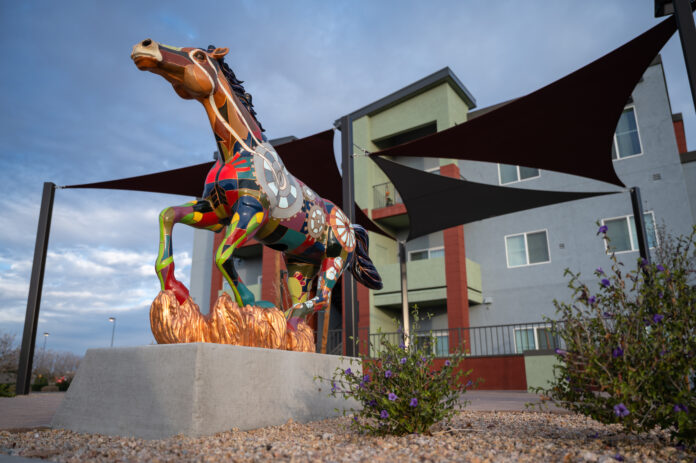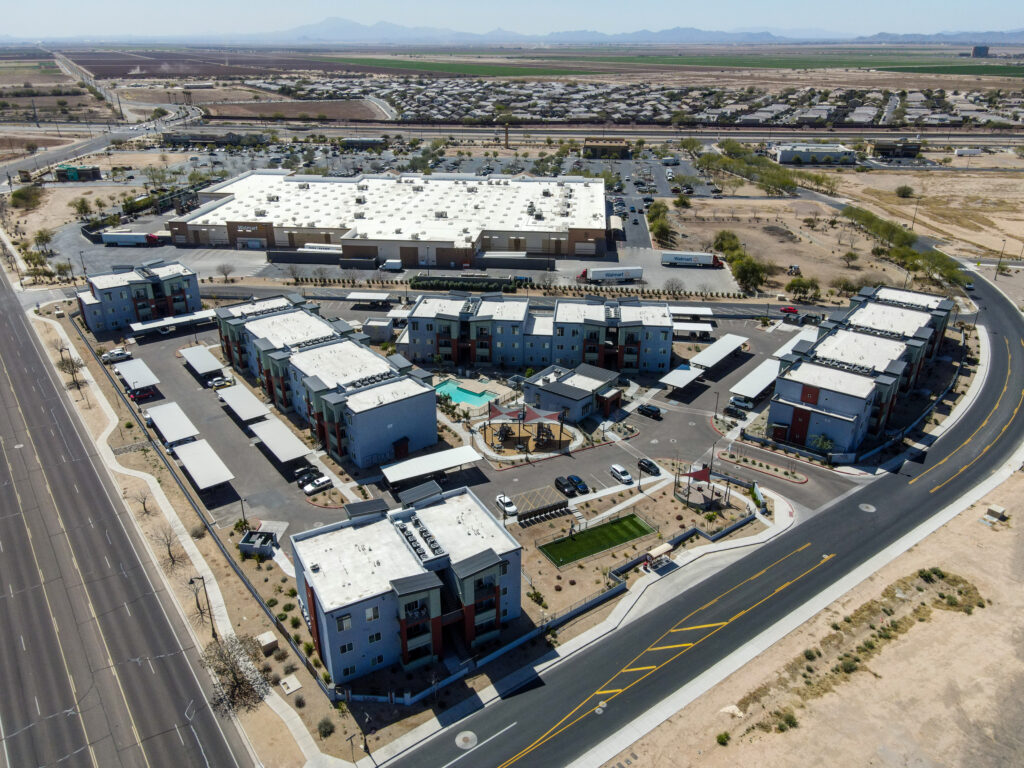
For years, housing in Maricopa came in one form: single-family homes.
But as rapid growth continues in Maricopa and the region, efforts to meet the need for diverse housing are on the rise.
There is currently only one apartment complex in Maricopa, Oasis at the Wells, which opened in spring 2021. But others are coming.
Copa Flats, a 312-unit, three-story apartment complex broke ground in March and represents the crest of a wave of multi-family communities — and more than 900 additional units — on the way.
To better understand the past, present and future of multi-family communities in Maricopa, it is best to start at the beginning.
A brief history
Apartments were never illegal in Maricopa. They were a difficult investment due to unfriendly zoning laws. That changed in 2017 when the city put forth a housing plan that improved zoning requirements for apartments and other housing options.
But one of the biggest hurdles to building an apartment complex in Maricopa was the market itself. The housing market crashed in 2008 and a home could be bought for less than $50,000. As Maricopa Mayor Christian Price noted, that meant cheap mortgage payments.
“Why would you rent an apartment for $1,200 with two bedrooms, when you could buy a house for $800 a month and have four beds, three bathrooms and a yard?” Price said.
For years, buying in Maricopa was more affordable than renting.
“The market didn’t allow it [apartments] to happen,” Price said. “Then we went into the recession, that exacerbated the problem because homes were being purchased for $30,000 and $40,000.”
Apartments were impossible at every level.
“Those mortgage payments were $300,” Price said. “How am I going to build an apartment complex, at how many millions of dollars, and charge you $1,500 rent?”
“How many people do you think you’re going to have lined up waiting to come into that marketplace? Zero. So that’s a failed concept. There’s no bank in America that would have given you a loan to do that.”

Apartments are a touchy subject for some residents who fear they will change the fabric of the community.
City Manager Rick Horst feels public perception is misguided.
“This thing about apartments and higher-density housing creating crime is a misnomer,” Horst said. “The facts bear that out. As soon as we hear something happening in an apartment, we jump to conclusions.”
Maricopa Police Chief James Hughes said both in studies and in his personal experience, crime in apartment complexes mirrors the surrounding community.
“Many studies have not found a correlation between apartment buildings and an increase in crime,” Hughes said. “There are certainly too many variables involved to conclude apartments increase crime. In my experience, apartment buildings in desirable communities with low crime have a positive economic benefit to the community by creating housing options based on the individual’s stage of adult life.”
Hughes said that given Maricopa’s already-low violent-crime rates, statistics can be misleading.
“The numbers (here) look to be within normal parameters,” Hughes said. “Maricopa enjoys small sample sizes regarding violent crime; therefore, two or three incidents can cause a larger percentage increase.”
There were 1,899 crimes reported in Maricopa in 2021, with 28 (or 1.2%) of them occurring at Oasis at The Wells. Six percent of all the burglaries in the city and 5% of assaults/shootings were reported at the complex, according to MPD statistics.
Most people associate federally-funded housing with apartments. Horst explained that in Maricopa, that’s not the case.
“These, for the most part, are market-rate housing. They’re not HUD housing.
“Matter of fact, most people don’t know it, but we do have some HUD housing in town.
“They’ve been in town way before the city was formed. We’ve never had an issue with those places. They look great. They are clean, they’re presentable and most people don’t even know they exist. There are less than 20 units.”
Damages already done
Maricopa has suffered from a lack of housing options for years. Horst believes that may have already affected Maricopa in an unfortunate way.
“There is a circle of life, and it implies that you have that young person, or young couple, getting started in life,” Horst said. “And when I think about those people, I think about my police officers, my firefighters, our schoolteachers. People like that, who cannot afford to jump into a $400,000 house, which is now, our starting average here in Maricopa.”
As a result, many service employees settle in bordering communities and counties where they can afford to live. Their kids attend the schools and they become part of the social fabric of that community, even though they work in Maricopa.
“So, what do they do?” Horst said. “They have to have a place to live, so we asked them to live in another community, but work here. Years ago, our police officers and firefighters had to live in another community. Because frankly, we didn’t have any homes.”
It also affects older people, Horst explained.
“And then at some point, they’re an empty-nester and want to downsize from that three- or four-bedroom house,” Horst said. “They can’t afford the cost of the maintenance or maybe they want to enjoy life.
“Where do they go? Do we ask them to leave the community, to leave their church, to leave their families and friends, to go somewhere else? Or do we provide an opportunity for them to start downsizing? What happens when you lose a spouse?”
The apartments, Horst said, also serve another purpose. Service employees who would typically work at the sit-down restaurants that residents are clamoring for need somewhere to live.
“Who’s going to take those $16-, $17-, $18-an-hour jobs?” Horst said. “They are not the people coming from Chandler or somewhere else. They are not going to drive all the way here for our $17- or $18-an-hour job.”
Price said part of healthy growth for the city is allowing people of different economic and social backgrounds the chance to settle and build a life in Maricopa.
“If we don’t have attainable housing, then we are literally shutting people out,” Price said. “This is a city that is growing exceptionally rapidly. In doing so, we have lots of new areas for stores coming online. We have lots of new police officers and nurses and firefighters, etc., and all these people make a great living and do a wonderful service. But if they’re just starting out in life, they have no place to live.”
Growth is coming
The Phoenix area is expected to grow by 881,000 people this decade, according to research conducted by the Greater Phoenix Economic Council (GPEC). While that number seems astronomical, it would only be the third-highest growth decade the Valley has seen. Metro Phoenix grew by 1.013 million in the 1990s and 941,000 in the 2000s. By the end of the decade, the Valley will be home to 5.4 million people.
Along with new residents will come new jobs, according to the same GPEC study. While experts hesitate to project job growth out more than a year or two, the forecast for the next two years is rosy. After 4% job growth in 2021, employment is expected to grow by a whopping 5.3% in 2022, followed by a robust 4.3% in 2023. And that takes into account population growth of about 90,000 people in each of those years.
There is a perception Arizona has an older population, but demographic statistics say otherwise. In fact, the five most populous ages in the state are those 25-29; each of those ages has more than 105,000 people. And the next six most-populous ages are 19 to 33, the only other groups with populations of more than 100,000 statewide.
Skyrocketing costs
Home affordability is another issue in a skyrocketing housing market. According to a study performed by research firm Elliot D. Pollack and Company, the only professions that could afford to buy a home of nine surveyed in 2020 were nurses and police officers — and they could only buy in eight and seven of the cities profiled, respectively. Fast forward a year to 2021 and only the nurse, making about $83,300 a year, can afford to buy, and only in three cities: Avondale, Glendale and Peoria.
Another factor in the need for apartments is the lack of existing home inventory. The Pollack study found the long-run average days of inventory for homes on the market priced at $350,000 or less in metro Phoenix has been 51 days; the current average is 10 days.
The total inventory long-run average supply has been 69 days, but currently sits at 23 days. In terms of total home inventory, in mid-2020, the average daily inventory of homes was 1,631; it’s currently 542. That’s the total number of resale homes available in a market of 4.5 million people.
It’s not just the price of buying a home that’s surging.
Eric Omdahl, a partner with Minnesota-based Real Estate Equities, developer of Copa Flats, said many would-be renters are being priced out of the market in the Valley.
“Our target is people who live in this community who have seen the 20% spike in rent they’re paying in the Valley over the last year,” Omdahl said. “There are a number of new employment uses coming to Maricopa as part of the growth of the community, and we see this as a viable housing choice for people who don’t want to get priced out of the market with single-family homes, which are now exceeding $2,000 a month on a rental basis.
“Not everyone can afford to put money down and get financing for a loan, so this is a good opportunity to provide a rental housing choice,” he said.
Bill Bisanz, CEO of the Real Estate Equities, noted while many areas in the region need apartments, Maricopa’s situation is unique.
“There was a combination of reasons that this was attractive and interesting for us here,” Bisanz said. “Your community, your state, is going through tremendous growth, and when that happens it adds even more pressure to housing affordability.
“There’s a huge need, a huge need we felt we could help with. Also, the circumstances were positive with some of the financing resources and the availability of tax-exempt bonds was favorable as well. Eric had experience here, and we wanted to expand, and we like the business climate as well. Those are the main reasons.”
This story was first published in the April edition of InMaricopa magazine.

![3 things to know about the new city budget Vice Mayor Amber Liermann and Councilmember Eric Goettl review parts of the city's 2024 operational budget with Mayor Nancy Smith on April 24, 2024. [Monica D. Spencer]](https://www.inmaricopa.com/wp-content/uploads/2024/04/spencer-042424-preliminary-budget-meeting-web-218x150.jpg)






![MHS G.O.A.T. a ‘rookie sleeper’ in NFL draft Arizona Wildcats wide receiver Jacob Cowing speaks to the press after a practice Aug. 11, 2023. [Bryan Mordt]](https://www.inmaricopa.com/wp-content/uploads/2024/04/cowing-overlay-3-218x150.png)



![Alleged car thief released without charges Phoenix police stop a stolen vehicle on April 20, 2024. [Facebook]](https://www.inmaricopa.com/wp-content/uploads/2024/04/IMG_5040-218x150.jpg)

![3 things to know about the new city budget Vice Mayor Amber Liermann and Councilmember Eric Goettl review parts of the city's 2024 operational budget with Mayor Nancy Smith on April 24, 2024. [Monica D. Spencer]](https://www.inmaricopa.com/wp-content/uploads/2024/04/spencer-042424-preliminary-budget-meeting-web-100x70.jpg)


